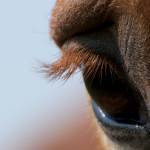Bad Hair Days: Seasonal Alopecia in Horses

Horses grow a heavy, thick winter coat that sheds in the spring to be replaced by a lighter summer coat. This normal pattern is triggered by the shortening and lengthening of daylight periods as the seasons change, not environmental temperature. The pineal gland responds to the changes in daylight, producing more or less melatonin and thus influencing hair growth.
Some horses vary from the normal pattern, growing hair at regular times but soon losing it over some areas of the body. Known as seasonal alopecia, this condition may be caused by an imbalance in the pineal gland. Melatonin supplementation has been used to treat a similar condition in dogs, but little is known about the effects of melatonin supplementation in horses.
Stress and/or fever can also cause hair loss (telogen effluvium). An important cause of hair coat abnormalities in older horses is pituitary pars intermedia dysfunction (equine Cushing’s disease).
Fluorescent or quartz halogen lighting in stables and paddocks may be an influence on unusual shedding because the light wavelength from these sources is similar to that of natural sunlight. Keeping a horse on a more natural lighting schedule may help to prevent hair loss.
Horses that lose too much hair in the winter may need to be blanketed for warmth, and those that develop a very thin coat in the summer should be observed for sunburn. Other than these considerations, seasonal alopecia is not known to have negative effects on a horse’s health.
Consult your veterinarian about any horse that has unusual hair loss, especially if is itchy or has other clinical signs of dermatitis. Diagnostic tests such as skin biopsy, skin scraping, and fungal culture can help to find a definitive diagnosis.








